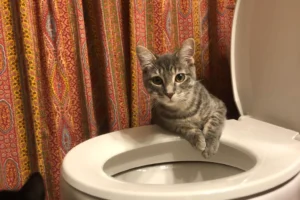Cats can be finicky creatures, especially when it comes to their bathroom habits. If you’ve ever wondered why your cat pees in the litter box but refuses to poop in it, you’re not alone. In this blog post, we’ll explore the reasons behind this behavior and provide some tips on how to address it.
The Importance of a Clean Litter Box
Having a clean litter box is crucial for keeping your cat comfortable and satisfied with their bathroom habits. Just like us, cats prefer a clean environment when they need to go. A dirty litter box can be a big turn-off for your feline friend, especially when it comes to pooping. Cats are known for their cleanliness and won’t hesitate to find an alternative spot if their litter box is not up to their standards.
Regularly scooping out waste and changing the litter can help prevent your cat from seeking other places to poop. Cats are sensitive creatures, and they appreciate a clean and inviting bathroom space. By maintaining a clean litter box, you are showing your cat that you care about their needs and well-being. This simple act can greatly impact your cat’s behavior when it comes to using the litter box for both peeing and pooping.
Size and Placement Matters
The size and placement of your cat’s litter box play a significant role in their willingness to use it for both pee and poop. Cats prefer a litter box that is large enough for them to move around comfortably. If the litter box is too small or cramped, your cat may feel confined and opt to find another spot to relieve themselves.
Additionally, the location of the litter box is crucial. Cats prefer a quiet and private area for their bathroom needs. Placing the litter box in a loud or high-traffic area can deter your cat from using it. Ensure the litter box is placed in a peaceful and easily accessible spot where your cat feels safe and secure.
When it comes to the size and placement of the litter box, consider your cat’s preferences and behaviors. Observing how your cat interacts with their litter box can help you determine if any adjustments need to be made. By providing a suitable litter box size and location, you can encourage your cat to use it regularly for both pee and poop.
Additional Insight:
- Consider having multiple litter boxes in different areas of your home to cater to your cat’s preferences and ensure easy access at all times.
The Psychological Factor
If your cat is peeing but not pooping in the litter box, it could be due to stress or anxiety. Cats are sensitive animals, and changes in their environment or routine can affect their bathroom habits. Make sure your cat has a quiet, safe space to eliminate, and try to keep their litter box in a low-traffic area. Provide plenty of enrichment, such as toys and scratching posts, to help reduce their stress levels.
Unique Insight: Cats are creatures of habit, so any disruptions to their routine can lead to litter box issues. If you recently moved the litter box or changed the type of litter, your cat may need time to adjust. Be patient and give them time to adapt to the new setup.
Medical Issues to Consider
If your cat is avoiding pooping in the litter box, it’s essential to rule out any underlying medical conditions. Constipation, diarrhea, or other gastrointestinal issues can make it uncomfortable for your cat to use the litter box. Schedule a visit to the vet to rule out any potential health concerns and discuss appropriate treatment options.
In addition to medical conditions, consider the size and accessibility of the litter box. Some cats may avoid using a litter box that is too small or difficult to enter, especially if they are senior cats or have mobility issues. Ensure the litter box is large enough for your cat to comfortably move around and has low sides for easy entry.
Introducing Multiple Litter Boxes
If your cat is only peeing in the litter box but not pooping, it could be due to a territorial issue or simply a preference for separate areas for each activity. By introducing multiple litter boxes in different locations around your home, you can give your cat the option to choose where they feel most comfortable doing their business.
Having multiple litter boxes also reduces the chance of one box becoming too soiled for your cat’s liking. Remember, cats are clean creatures and may avoid using a dirty litter box. Ensure each box is regularly cleaned to maintain a pleasant environment for your cat.
For multiple cat households, having at least one litter box per cat plus one extra is recommended to prevent territorial disputes. Each cat should have their own designated box to reduce competition and encourage consistent litter box use for both peeing and pooping.
Additional Unique Insight: Consider the type of litter in each box. Some cats may have preferences for certain textures or scents, so offering a variety of litter options in different boxes could encourage more consistent use.
The Power of Positive Reinforcement
Encouraging your cat to use the litter box for both pee and poop can be achieved through positive reinforcement. Whenever you catch your cat using the litter box correctly, reward them with treats, praise, or playtime. Positive associations with the litter box can reinforce good behavior.
If your cat has an accident outside the litter box, avoid punishment as this can create a negative association with the box. Instead, clean up the mess thoroughly and remain patient and consistent in providing positive reinforcement when they use the box appropriately.
Consistency is key when using positive reinforcement. Ensure your cat has easy access to the litter boxes and that they are always kept clean and inviting. With patience and positive reinforcement, you can encourage your cat to use the litter box for all their bathroom needs.
Remember, cats respond best to positive reinforcement rather than punishment. Keep a positive and patient attitude when guiding your cat towards using the litter box consistently.
Seeking Professional Help
If your cat consistently pees but refuses to poop in the litter box, it might be time to seek help from a veterinarian or animal behaviorist. Persistent litter box issues could signal an underlying health problem or behavioral issue that requires expert attention. Don’t delay in getting your feline friend the help they need to ensure their well-being.
When you notice unusual bathroom habits in your cat, such as avoiding the litter box for defecation, it’s essential to rule out any medical conditions like urinary tract infections, constipation, or gastrointestinal issues. A vet can conduct necessary tests to diagnose and treat any health concerns that may be causing your cat’s litter box aversion.
Moreover, consulting with an animal behaviorist can provide valuable insights into your cat’s behavior and help address any underlying environmental stressors contributing to their litter box aversion. They can offer tailored solutions to modify your cat’s litter box habits and create a more comfortable and appealing bathroom environment for them.
Taking proactive steps to address your cat’s litter box issues with the help of professionals can lead to a happier and healthier relationship between you and your feline companion. Prioritize your cat’s well-being by seeking the expertise of a veterinarian or animal behaviorist to address any concerning litter box behavior effectively.
Fun Facts About Cat Behavior
Cats are fascinating creatures with unique bathroom habits that may surprise you. Did you know that a cat’s peeing and pooping behavior in the litter box can be influenced by various factors, including their territorial instincts and preferences for cleanliness? Understanding these fun facts about cat behavior can provide valuable insights into why your feline friend may be peeing but not pooping in the litter box.
Scent Marking : Cats are known for their territorial behavior, and urinating in specific locations, such as the litter box, can serve as a way for them to mark their territory with their scent. This may explain why your cat pees but avoids defecating in the litter box.
Preference for Cleanliness : Cats are clean animals and may be deterred from using a soiled litter box. Ensuring regular litter box cleanings and providing different litter options can help address your cat’s bathroom habits effectively.
Stress and Anxiety : Environmental stressors, changes in routine, or anxiety can also impact a cat’s litter box behavior. Creating a calm and stress-free environment for your cat can encourage them to use the litter box appropriately.
Multiple Boxes : Having multiple litter boxes in different areas of your home can cater to your cat’s preferences and reduce competition among multiple cats in a household.
By embracing these fun facts about cat behavior, you can better understand and address your cat’s litter box issues, promoting a harmonious relationship between you and your beloved pet. Embrace your cat’s quirks and behaviors to provide a supportive and comfortable environment for them.
Alex, a passionate animal lover, has experience in training and understanding animal behavior. As a proud pet parent to two dogs and three cats, he founded AnimalReport.net to share insights from animal experts and expand his knowledge of the animal kingdom.




